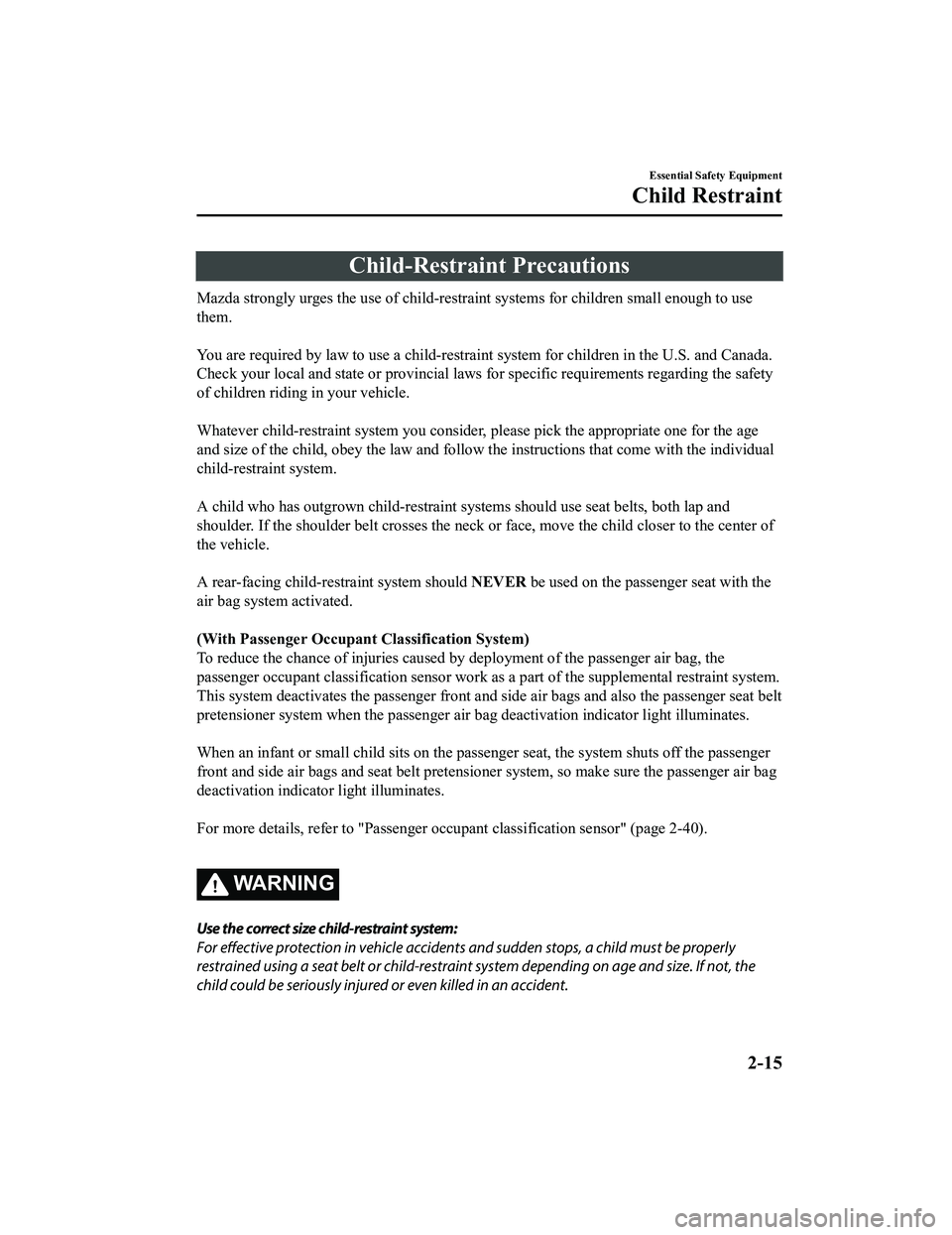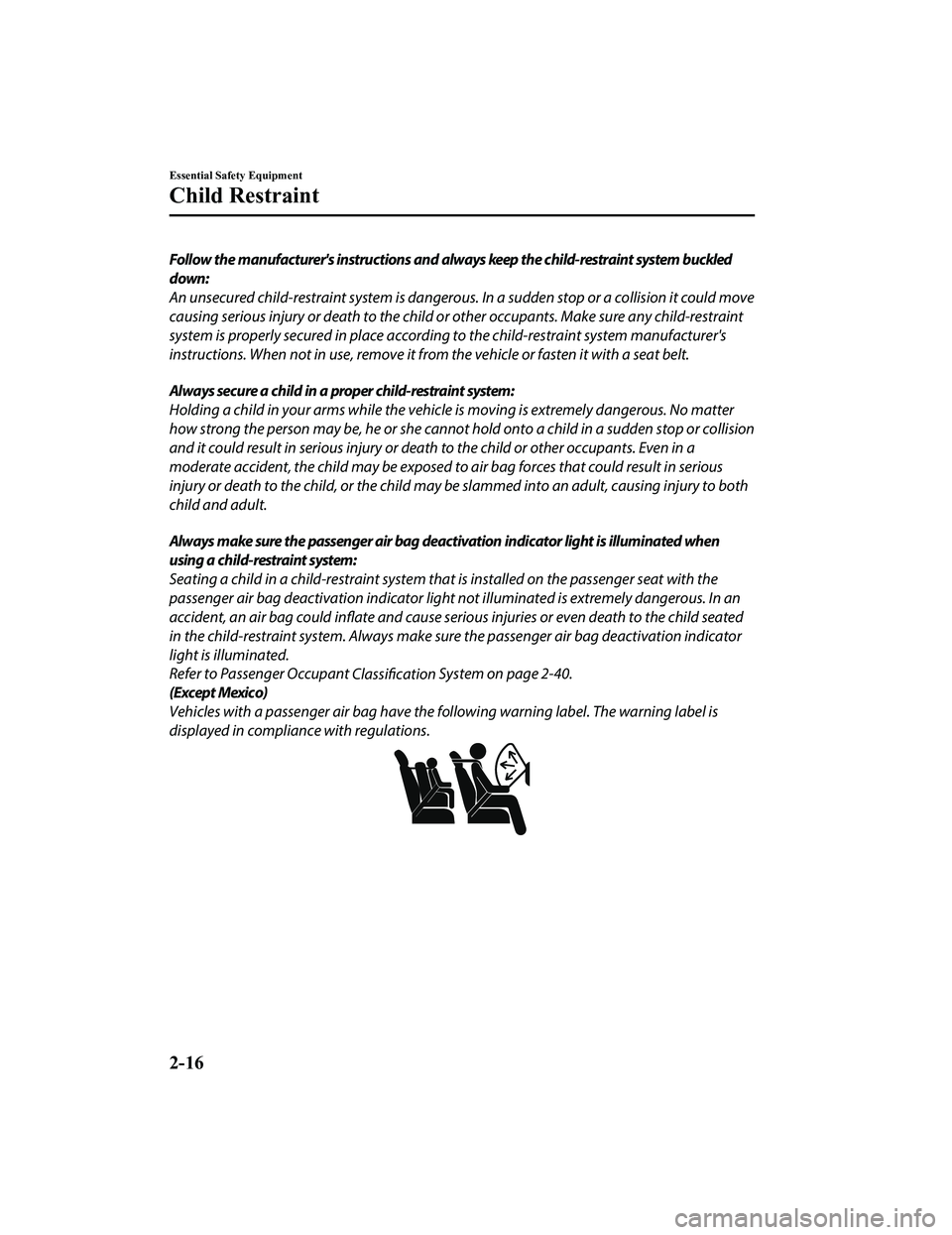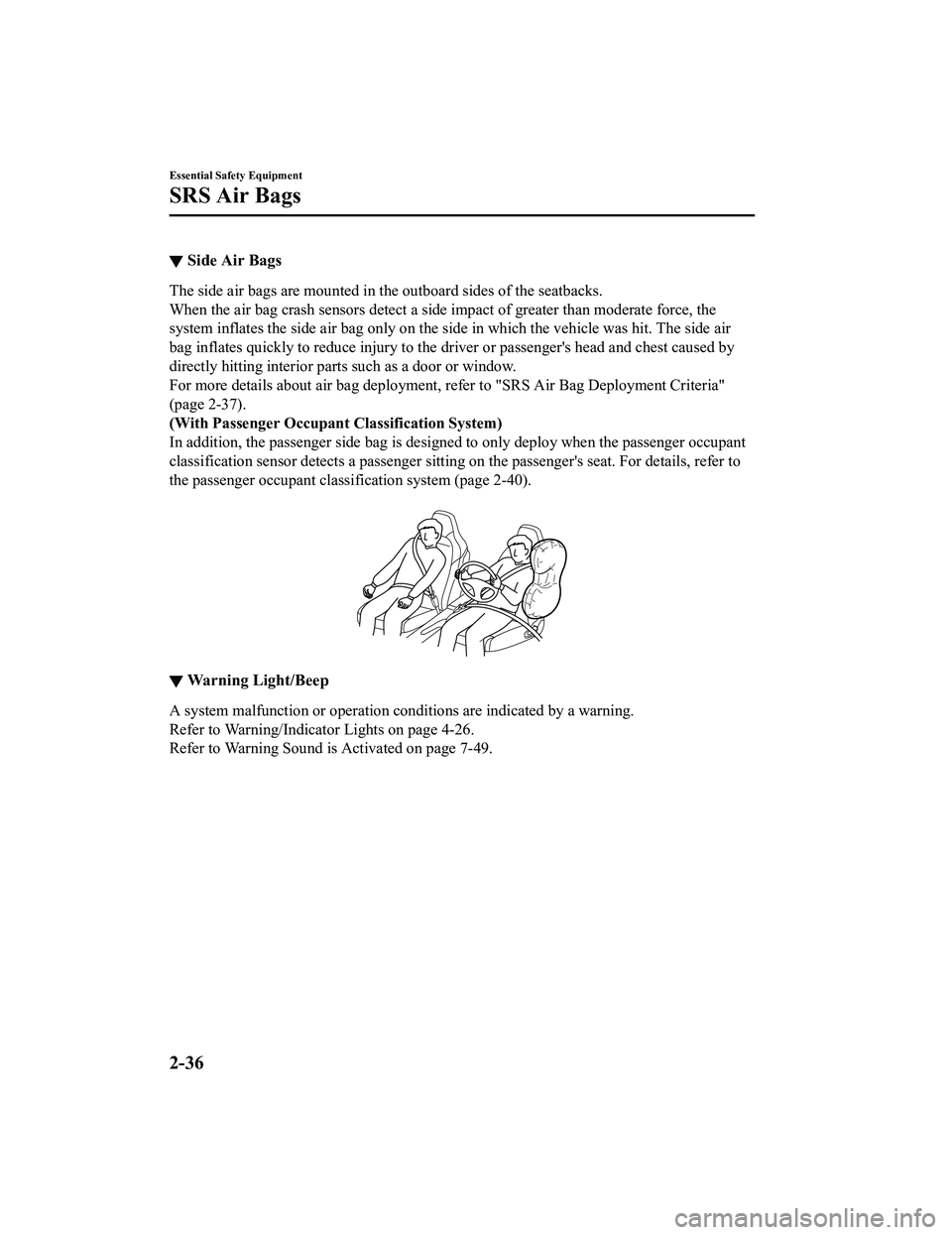light MAZDA MODEL MX-5 MIATA 2018 User Guide
[x] Cancel search | Manufacturer: MAZDA, Model Year: 2018, Model line: MODEL MX-5 MIATA, Model: MAZDA MODEL MX-5 MIATA 2018Pages: 576, PDF Size: 55.37 MB
Page 29 of 576

Child-Restraint Precautions
Mazda strongly urges the use of child-restraint systems for children small enough to use
them.
You are required by law to use a child-restraint system for children in the U.S. and Canada.
Check your local and state or pro vincial laws for specific requirements regarding the safety
of children riding in your vehicle.
Whatever child-restraint system you consider, please pick the a ppropriate one for the age
and size of the child, obey the law and follow the instructions that come with the individual
child-restraint system.
A child who has outgrown child-restraint systems should use sea t belts, both lap and
shoulder. If the shoulder belt crosses the neck or face, move t he child closer to the center of
the vehicle.
A rear-facing child-restraint system should NEVER be used on the passenger seat with the
air bag system activated.
(With Passenger Occupant Classification System)
To reduce the chance of injuries caused by deployment of the passenger air bag, the
passenger occupant classification sensor work as a part of the supplemental restraint system.
This system deactivates the passenger front and side air bags and also the passenger seat belt
pretensioner system when the passenger air bag deactivation ind icator light illuminates.
When an infant or small child sits on the passenger seat, the s ystem shuts off the passenger
front and side air bags and seat belt pretensioner system, so m ake sure the passenger air bag
deactivation indicator light illuminates.
For more details, refe r to "Passenger occupant classification s ensor" (page 2-40).
WA R N I N G
Use the correct size child-restraint system:
For effective protection in ve hicle accidents and sudden stop s, a child must be properly
restrained using a seat belt or child-restraint system depending on age and size. If not, the
child could be seriously injured or even killed in an accident.
Essential Safety Equipment
Child Restraint
2-15
MX-5_8GF7-EA-17J_Edition2 2017-10-31 14:07:27
Page 30 of 576

Follow the manufacturer's instructions and always keep the child-restraint system buckled
down:
An unsecured child-restraint system is dangerous. In a sudden stop or a collision it could move
causing serious injury or death to the child or other occupants. Make sure any child-restraint
system is properly secured in place according to the child-restraint system manufacturer's
instructions. When not in use, remove it from the vehicle or fasten it with a seat belt.
Always secure a child in a proper child-restraint system:
Holding a child in your arms while the vehicle is moving is extremely dangerous. No matter
how strong the person may be, he or she cannot hold onto a child in a sudden stop or collision
and it could result in serious injury or death to the child or other occupants. Even in a
moderate accident, the child may be exposed to air bag forces that could result in serious
injury or death to the child, or the child may be slammed into an adult, causing injury to both
child and adult.
Always make sure the passenger air bag deactivation indicator light is illuminated when
using a child-restraint system:
Seating a child in a child-restraint system that is installed on the passenger seat with the
passenger air bag deactivation indicator light not illuminated is extremely dangerous. In an
accident, an air bag could inflate and cause serious injuries or even death to the child seated
in the child-restraint system. Always make sure the passenger air bag deactivation indicator
light is illuminated.
Refer to Passenger Occupant Classification System on page 2-40.
(Except Mexico)
Vehicles with a passenger air bag have the fo llowing warning label. The warning label is
displayed in compliance with regulations.
Essential Safety Equipment
Child Restraint
2-16
MX-5_8GF7-EA-17J_Edition2 2017-10-31 14:07:27
Page 38 of 576

2. Slide the seat as far back as possible.
3. Place the child-res traint system on the
seat without putting your weight on the
seat and secure the child-restraint
system with the lap portion of the lap/
shoulder belt. See the manufacturer's
instructions on the child-restraint
system for belt routing instructions.
4. To get the retractor into the automatic
locking mode, pull the shoulder belt
portion of the seat belt until the entire
length of the belt is out of the retractor.
5. Push the child-restraint system firmly
into the vehicle sea t. Be sure the belt
retracts as snugly as possible. A
clicking noise from the retractor will
be heard during retraction if the system
is in automatic lo cking mode. If the
belt does not lock the seat down tight,
repeat the previous step and also this
one.
NOTE
ï·Inspect this function before each use
of the child-restraint system. You
should not be able to pull the
shoulder belt out of the retractor
while the system is in the automatic
locking mode. When you remove the
child-restraint system, be sure the
belt fully retracts to return the
system to emergency locking mode
before occupants use the seat belts.
6. Seat your child safely in the child-restraint system and secure the
child according to the instructions
from the child-restraint system
manufacturer.
7. Switch the ignition ON and make sure the passenger air bag deactivation
indicator light illuminates after
installing a child-restraint system on
the passenger seat.
If the passenger a ir bag deactivation
indicator light does not illuminate,
remove the child-restraint system,
switch the ignition to OFF, and then
re-install the chil d-restraint system
(page 2-40).
Essential Safety Equipment
Child Restraint
2-24
MX-5_8GF7-EA-17J_Edition2 2017-10-31 14:07:27
Page 39 of 576

WA R N I N G
Do not seat a child in a child-restraint
system on the passenger seat if the
passenger air bag deactivation indicator
light does not illuminate (With Passenger
Occupant Classification System):
Seating a child in a child-restraint system
installed on the passenger seat with the
passenger air bag deactivation indicator
light not illuminated is dangerous. If this
indicator light does not illuminate, this
means that the passenger front and side air
bags, and seat belt pretensioner are ready
for deployment. If an accident were to
deploy an air bag, a child in a
child-restraint system sitting in the
passenger seat could be seriously injured or
killed. If the indicator light does not
illuminate after seating a child in a
child-restraint system on the passenger
seat consult an Authorized Mazda Dealer
as soon as possible.
Essential Safety Equipment
Child Restraint
2-25
MX-5_8GF7-EA-17J_Edition2 2017-10-31 14:07:27
Page 41 of 576

If your vehicle is also equipped with a passenger occupant classification system, refer
to the Passenger Occupant Classification System (page 2-40) for details.
If your vehicle is equipped with a passenger occupant classification system, the passenger
air bag deactivation indicator light illuminates for a specifie d time after the ignition is
switched ON.
Small children mu st be protected by a child-restraint system as stipulated by law in every
state and province. In certain s tates and provinces, larger children must use a child-restraint
system (page 2-15).
Carefully consider which child-restraint system is necessary fo r your child and follow the
installation directions in this Owner's Manual as well as the c hild-restraint system
manufacturer's instructions.
Do not use a child-restraint system which employs an upper teth er because there is no
appropriate means to anchor the tether.
WA R N I N G
Seat belts must be worn in air bag equipped vehicles:
Depending only on the air bags for protection during an accident is dangerous. Alone, air
bags may not prevent serious injuries. The appr opriate air bags can be expected to inflate
only in the first accident, such as frontal, near frontal or side collisions that are at least
moderate. Vehicle occupants shou ld always wear seat belts.
Always make sure the passenger air bag deactivation indicator light is illuminated when
using a child-restraint system (With Passenger Occupant Classification System):
Seating a child in a child-restraint system that is installed on the passenger seat with the
passenger air bag deactivation indicator light not illuminated is extremely dangerous. In an
accident, an air bag could inflate and cause seri ous injuries or even death to the child seated
in the child-restraint system. Always make su re the passenger air bag deactivation indicator
light is illuminated.
Refer to Occupant Classification System on page 2-40.
Essential Safety Equipment
SRS Air Bags
2-27
MX-5_8GF7-EA-17J_Edition2 2017-10-31 14:07:27
Page 44 of 576

Do not operate a vehicle with damaged air bag/seat belt pretensioner system components:
Expended or damaged air bag/seat belt pretensioner system components must be replaced
after any collision which caused them to depl oy or damage them. Only a trained Authorized
Mazda Dealer can fully evaluate these systems to see that they will work in any subsequent
accident. Driving with an expended or damage d air bag or pretensioner unit will not afford
you the necessary protection in the event of any subsequent accident which could result in
serious injury or death.
Do not remove interior air bag parts:
Removing any components such as the seats, front dashboard, the steering wheel, containing
air bag parts or sensors is dangerous. These pa rts contain essential air bag components. The
air bag could accidentally activate and cause serious injuries. Always have an Authorized
Mazda Dealer remove these parts.
Properly dispose of the air bag system:
Improper disposal of an air bag or a vehicle with live air bags in it can be extremely
dangerous. Unless all safety procedures are foll owed, injury could result. Have an Authorized
Mazda Dealer safely dispose of the air bag sy stem or scrap an air bag equipped vehicle.
NOTE
ï·If it becomes necessary to have the components or wiring system for the supplementary
restraint system modified to accommodate a person with certain medical conditions in
accordance with a certified physician, contact an Authorized Mazda Dealer, refer to
âCustomer Assistance (U.S.A.)â (page 8-2).
ï·When an air bag deploys, a loud inflation noise can be heard and some smoke will be
released. Neither is likely to cause injury, however, the text ure of the air bags may cause
light skin injuries on body parts not covered with clothing through friction.
ï·Should you sell your Mazda, we urge you to tell the new owner of its air bag systems and
that familiarization with all instructions about them, from the Owner's Manual, is
important.
ï·Vehicles with a passenger air bag have a warning label attached as shown in the
following.
(Except Mexico)
This warning label is displayed in compliance with regulations.
Essential Safety Equipment
SRS Air Bags
2-30
MX-5_8GF7-EA-17J_Edition2 2017-10-31 14:07:27
Page 47 of 576

(Without Passenger Occupant Classification System)
Driver/Passenger inflators and air bags
Crash sensors, and diagnostic module (SAS unit)
Seat belt pretensioners (page 2-11)
Front air bag sensors
Side crash sensors
Air bag/seat belt pretensioner system warning light (page 4-26 )
Side inflators and air bags
Passenger air bag deactivation indicator light* (page 2-40)
Passenger occupant classification sensor* (page 2-40)
Passenger occupant classification module*
Essential Safety Equipment
SRS Air Bags
*Some models.2-33
MX-5_8GF7-EA-17J_Edition2 2017-10-31 14:07:27
Page 50 of 576

â¼Side Air Bags
The side air bags are mounted in the outboard sides of the seat
backs.
When the air bag crash sensors detect a side impact of greater than moderate force, the
system inflates the side air bag only on the side in which the vehicle was hit. The side air
bag inflates quickly to reduce injury to the driv er or passenger's head and chest caused by
directly hitting interior pa rts such as a door or window.
For more details about air bag de ployment, refer to "SRS Air Bag Deployment Criteria"
(page 2-37).
(With Passenger Occupant Classification System)
In addition, the passenger side bag is designed to only deploy when the passenger occupant
classification sensor detects a passenger sitting on the passen ger's seat. For details, refer to
the passenger occupant classification system (page 2-40).
â¼ Warning Light/Beep
A system malfunction or operation conditions are indicated by a
warning.
Refer to Warning/Indicator Lights on page 4-26.
Refer to Warning Sound is Activated on page 7-49.
Essential Safety Equipment
SRS Air Bags
2-36
MX-5_8GF7-EA-17J_Edition2 2017-10-31 14:07:27
Page 54 of 576

Passenger Occupant Classification System*
First, please read "Supplemental Restraint System (SRS) Precaut ions" (page 2-26) carefully.
â¼Passenger Occupant Classification Sensor
Your vehicle is equipped with a p
assenger occupant classification sensor as a part of the
supplemental restraint system. This sensor is equipped in the p assenger's seat cushion. This
sensor measures the electrostatic capacity of the passenger's s eat. The SAS unit is designed
to prevent the passenger front and side air bags and seat belt pretensioner system from
deploying if the passenger air bag deactivation indicator light turns on.
To reduce the chance of injuries caused by deployment of the pa ssenger air bag, the system
deactivates the passenger front and side air bags and also the seat belt pretensioner system
when the passenger air bag deactivation indicator light turns o n. Refer to the following table
for the passenger air bag deactivation indicator light illumina tion conditions.
This system shuts off the passenger front and side air bags and seat belt pretensioner system,
so make sure the passenger air bag deactivation indicator light turns on according to the
following table.
The air bag/seat belt pretensioner system warning light flashes and the passenger air bag
deactivation indicator light illuminates if the sensors have a possible malfunction. If this
happens, the passenger front and side air bags and seat belt pr etensioner system will not
deploy.
Passenger air bag deactivation indicator light
This indicator light turns on to remind you that the passenger front and side air bags and seat
belt pretensioner will not deploy during a collision.
If the passenger occupant classi fication sensor is normal, the indicator light turns on when
the ignition is switched ON. The light t urns off after a few seconds. Then, the indicator light
turns on or is off under the following conditions:
Essential Safety Equipment
SRS Air Bags
2-40*Some models.
MX-5_8GF7-EA-17J_Edition2 2017-10-31 14:07:27
Page 55 of 576

Passenger air bag deactivation indicator light on/off condition chart
Condition detected by the pas-
senger occupant classification system Passenger air bag de-
activation indicator light Passenger front and
side air bags Passenger seat belt
pretensioner system
Empty (Not occupied) On Deactivated Deactivated
A child is seated in a child-re-
straint system
*1On Deactivated Deactivated
Adult
*2Off Ready Ready
*1 The occupant classification sensor may not detect a child seat ed on the seat, in a child-restraint system, or a
junior seat depending on the ch ild's physical size and seated posture.
*2 If a smaller adult sits on the passenger seat, the sensors might detect the person as being a child depending on
the person's physique.
If the passenger air bag deactivat ion indicator light does not turn on when the ignition is
switched ON and does not turn on as indicated in the passenger air bag deactivation
indicator light on/off condition chart, do not allow an occupan t to sit in the passenger seat
and consult an Authorized Mazda Dealer as soon as possible. The system may not work
properly in an accident.
WA R N I N G
Do not allow an occupant in the passenger's seat to sit with a posture which makes it difficult
for the passenger occupant classification sensor to detect the occupant correctly:
Sitting in the passenger's seat with a posture which makes it difficult for the passenger
occupant classification sensor to detect the occupant correctly is dangerous. If the passenger
occupant classification sensor cannot detect the occupant sitting on the passenger's seat
correctly, the passenger front and side air ba gs and pretensioner system may not operate
(non-deploy) or they may operate (deploy) a ccidentally. The passenger will not have the
supplementary protection of the air bags or th e accidental operation (deployment) of the air
bags could result in serious injury or death.
Under the following conditions, the passenger occu pant classification sensor cannot detect a
passenger sitting on the passenger's seat co rrectly and the deployment/non-deployment of
the air bags cannot be controlled as indicated in the passenger air bag deactivation indicator
light on/off condition chart. For example:
Essential Safety Equipment
SRS Air Bags
2-41
MX-5_8GF7-EA-17J_Edition2 2017-10-31 14:07:27